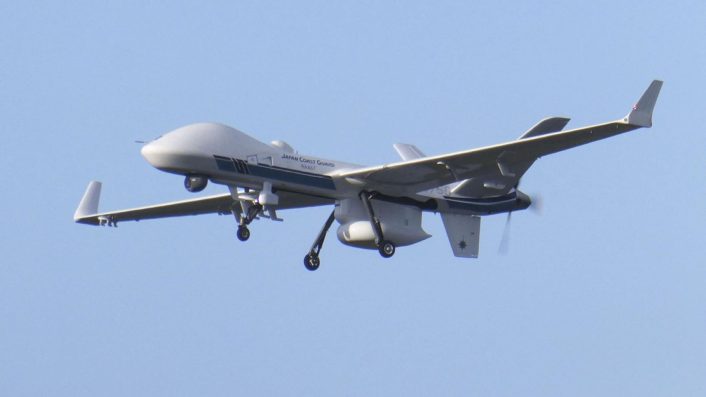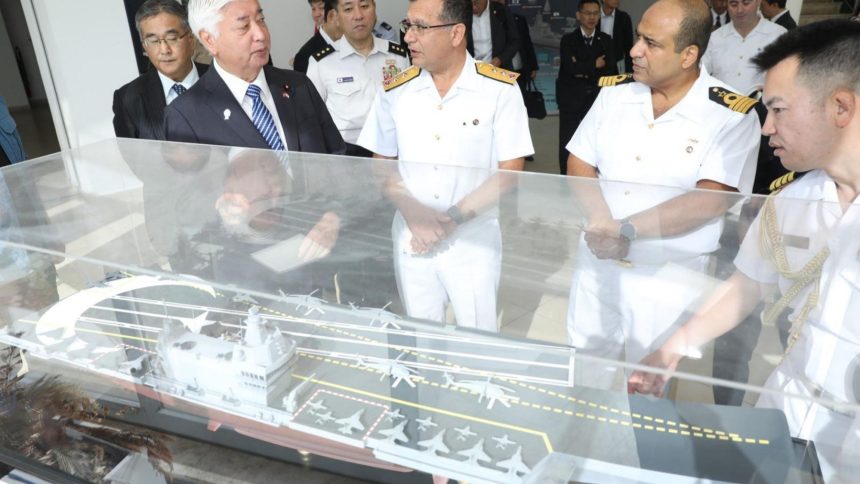Japan’s defense minister Gen Nakatani visited Turkey to enhance defense ties and, while there, also visited the facilities of Turkish Aerospace Industries, Istanbul Naval Shipyard and Baykar.
Japan and Turkey have set the stage for future defense commercial ties as Japanese Defense Minister Gen Nakatani met his Turkish counterpart and toured Turkish military industrial facilities on Aug. 19, 2025. While neither the Japanese MoD nor Turkey’s MND (Ministry of National Defense) identified the kind of systems Tokyo aims to buy from Ankara, reports from both countries and Reuters noted drones are among the systems being considered.
Nakatani’s visit to the facilities of TAI (Turkish Aerospace Industries), Istanbul Naval Shipyard and the leading UAV and aerospace major Baykar, supported by quotes in deep background by diplomatic officials on both sides, additionally suggest things are moving in that direction. The reports however clarified that Japan is still far away from immediately beginning acquiring Turkish military hardware.
Interestingly, the reports come on the same day as the Japan Coast Guard deployed one of its three GA-ASI MQ-9B Sea Guardian drones to monitor the Senkaku Islands “amid repeated incursions into nearby waters by Chinese vessels,” according to sources quoted by Japan Today.
Millî Savunma Bakanı Yaşar Güler, Japonya Savunma Bakanı Gen Nakatani ile Millî Savunma Bakanlığında bir araya geldi.
Bakan Yaşar Güler, askerî törenle karşıladığı konuk mevkidaşı ile baş başa görüşme gerçekleştirdi.
Her iki Bakan daha sonra heyetler arası toplantıya başkanlık… pic.twitter.com/jv4ivzTWBc
— T.C. Millî Savunma Bakanlığı (@tcsavunma) August 19, 2025
Nakatani is visiting the region as part of a larger tour from Aug. 17 to 22, including Djibouti and Jordan, and his meeting with his Turkish counterpart Yaşar Güler was the highlight of the visit. This also is the first visit by a Japanese defense minister to Turkey, which included an inter-delegation meeting of defense, consular and diplomatic officials. A working-group level committee between Japan’s ATLA (Acquisition, Technology and Logistics Agency) and Turkey’s SSB (Presidency of Defense Industries) will now take things forward.
DM Nakatani visited #Türkiye from Aug 19 to 20 and held a Defense Ministerial Meeting with Minister Güler. 🇯🇵 has enjoyed a longstanding amicable relationship with🇹🇷, and will further strengthen defense cooperation and exchanges.
Result Summary: https://t.co/NYCIu4vmQz pic.twitter.com/s42ThIIL3J
— Japan Ministry of Defense/Self-Defense Forces (@ModJapan_en) August 21, 2025
Visit and statements
The Japanese readout said the Japan-Turkey Defense Ministerial Meeting on Aug. 19 lasted nearly 100 minutes, where the two ministers “welcomed the advancements of cooperation between the defense authorities, such as high-level exchanges, unit-level exchanges and exchanges in the education field.” Additionally, the statement says the two Ministers affirmed the will to further expand defense cooperation and discuss concrete cooperative fields in the defense sector.
The two ministers “exchanged views on possible defense equipment and technology cooperation […] and […] concurred to start a discussion between the equipment authorities toward realizing exchanges between the defense industries,” further added the MoD. The press release then mentioned Nakatani’s visit to defense related facilities and companies, including Turkish Aerospace Industries, Istanbul Naval Shipyard, and Baykar.
Japan’s Def. Min. Nakatani wrapped up 2 day Turkey visit with a press conference confirming interest for Turkish drones while revealing Turkey is interested in Japan’s naval minesweeping capabilities. @Selcuk @haluk
Japanese MOD Presser Transcript Link :https://t.co/teWykZGcdM pic.twitter.com/lXccUT4kGI
— Sinan Tavsan (@SinanTavsan) August 21, 2025
According to Daily Sabah, Nakatani told journalists in Istanbul that they “agreed to begin discussions at the working group-level between our respective equipment authorities, with a view to facilitating exchanges between our defense industries.”
The broader strategic goal in the Japan MoD press release alluded to “tackling various challenges in the international community” and “collaborate together for the peace and stability of the region.” The Turkish MND quoted Güler: “We are ready to make every effort to achieve further development, particularly in the defense industry and military relations, with our Japanese friends.”
Drones
The reference to drones appeared in both Turkish and Japanese media reports. According to The Mainichi, the talks came as Japan has been “considering buying drones made in Turkey as part of its efforts to strengthen its surveillance and reconnaissance capabilities.”

All the reports further referenced Turkey’s supply of Bayraktar TB2 UCAVs to Ukraine that were extensively used and recorded successes in the first few months of 2022. An unidentified official told Reuters ahead of the meeting that the two sides “will hold inspections regarding drones, but an agreement is not expected” as it is “too early.”
“Turkey-backed firms have supplied drones to several countries, including Ukraine, while Japan is preparing to expand the use of unmanned aerial vehicles across its ground, air and naval forces,” Reuters added. Daily Sabah further said that, while Japan is interested in Turkey’s drone industry and Turkey is interested in Japan’s command and control functions, and there are wishes to review any export control frameworks, the talks “did not mean Japan would acquire Turkish-made defense products.”
Drones for Japan
According to The Japan Times, the MoD is pushing for a whopping $1.4 billion allocation for the FY2026 budget “towards the mass deployment of defensive air, sea and underwater drones,” amid China’s “increasingly assertive moves” around Japan’s air and maritime space. Japan’s 2022 Defense Buildup Program requires the SDFs (Self-Defense Forces) to “expeditiously procure various types of unmanned assets” by 2027.
1/3 A 🇯🇵 Def. Min. visiting 🇹🇷 for the first time, touring drone giants @BaykarTech & @TUSAS_TR. JP has US’s MQ-9B with a price tag $80 million +, while a TB2 estimated around $5 million. https://t.co/WjYoGmoT9N via @NikkeiAsia
— Sinan Tavsan (@SinanTavsan) August 20, 2025
These include long-endurance unmanned aerial vehicles and shipborne unmanned surveillance and reconnaissance assets, as well as unmanned aerial vehicles for “the rapid transport of supplies to widely dispersed deployed units, remote bases and naval vessels.”
TJT however added that, while the MoD is considering “relatively inexpensive foreign” systems for quick acquisition and induction, its “longer-term plans are to help boost domestic manufacturing” for “reinforcing supply chains of necessary parts.”
This also explains the unofficial quotes in the reports that said Tokyo will not begin purchasing Ankara’s UAVs right away, and might likely look for greater local production. Japan had also pushed for its own domestically-developed airborne EW (Electronic Warfare) aircraft based on the Kawasaki P-1 MPA.
Japan’s MQ-9B SeaGuardian
Regarding the SeaGuardian’s monitoring of Chinese Coast Guard vessels near the Senkaku Islands on Aug. 19, Japan Today said that it was one among many routine deployments using the drone by the service in the East China Sea, western Pacific and the Sea of Japan. The report added that the JCG will add two more SeaGuardians by March 2026.
#Japan acquires two additional MQ-9B #SeaGuardian drones to enhance maritime surveillancehttps://t.co/2VfYPGG1t7 pic.twitter.com/zoEx2Tk1Ng
— MIRAGEC14 (@JMESPARCIA) August 21, 2024
GA-ASI also announced on Dec. 3, 2024, that the JMSDF (Japan Maritime Self-Defense Force) selected the SeaGuardian for its Long Endurance UAV program, following its use of SeaGuardian since May 2023 as part of its Medium-Altitude, Long Endurance (MALE) RPA System Trial Operations Project.
Other Turkish posts said that the visit could open doors for Japan considering TAI’s Hürjet to replace its older Kawasaki T-4s. While Japan’s Mitsubishi Heavy Industries in May unveiled its T-X trainer concept, the Mainichi Shimbun reported in March 2024 that the country may have identified the Boeing-Saab T-7A Red Hawk as the possible candidate.









